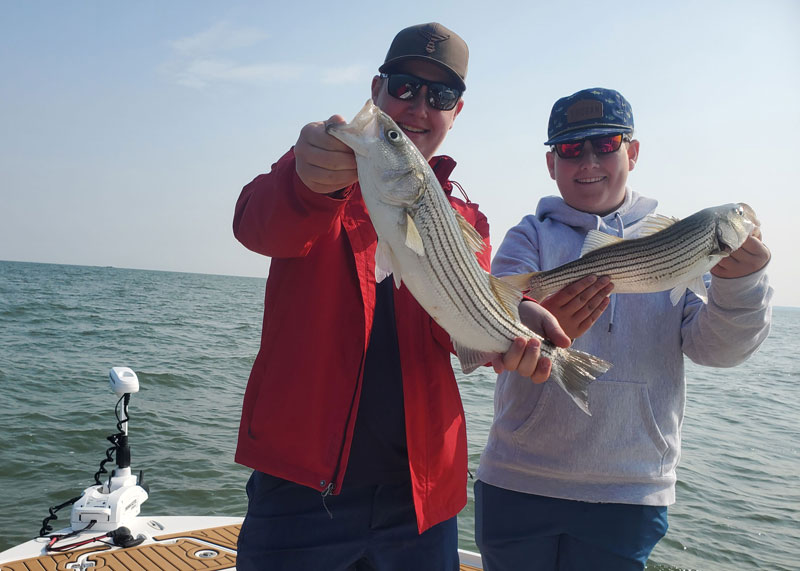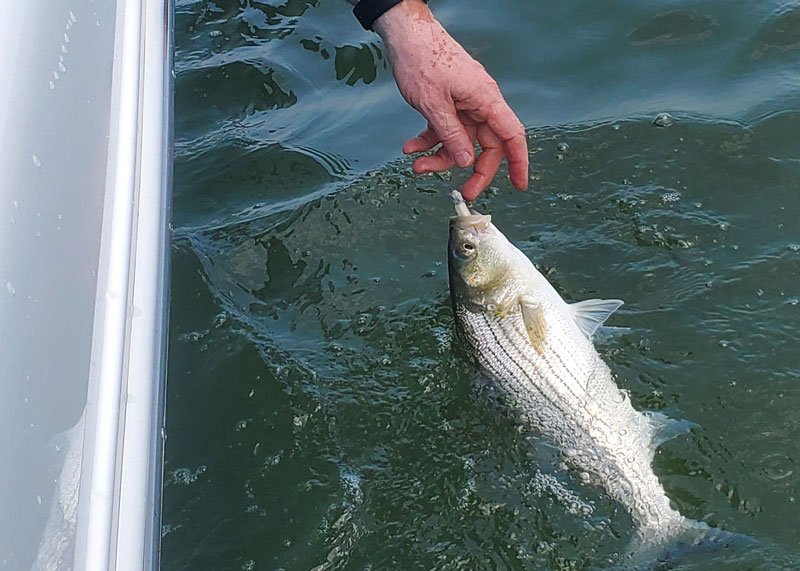These days, Chesapeake Bay anglers face a real problem when it comes to catching a striped bass for dinner: Argh — it stretches to 18.75! Argh — the tape shows 24.25! With a slot limit of 19” to 24”, sometimes you can catch unders and overs but you might still be going home without anything in the fishbox. How can you search specifically for fish inside that tight slot? There’s no magic bullet and we can’t measure the fish before we catch them, but there are a few things you can do to boost your chances of finding filletable fish.

Avoiding Under Slot Stripers
With the poor reproduction we’ve seen in recent years, we haven’t been seeing the same widespread mass schools of 12” to 16” fish we’ve had in the past. Still, you will sometimes spot birds on the horizon, race over, and discover dinks busting water. After catching a couple of the little guys and identifying the school as consisting of undersized fish, stop fishing in the frenzy. Sure it can be fun enjoying the nonstop action, but pound on those little guys and sooner or later you’ll injure or kill one by accident. Plus, all the while you’re coming no closer to weighing down the cooler. So instead, try getting below the fray. Sometimes larger fish will be on or near bottom, shadowing the school. Upsize your lure weight, cast 20 or 30 yards down-current of the fish (since any bigger ones in the neighborhood will be sitting there waiting for injured bait to drift down) and bounce along bottom. If you don’t get any takers or catch a couple more undersized fish, it’s time to move on.
You can also take in a bit of data by eyeballing the bait in the area. If there’s a preponderance of tiny bay anchovies, you know larger rockfish will be less interested in chasing them. But when palm-sized bunker are flipping around, the bigger baitfish are more likely to attract bigger fish. This doesn’t mean you won’t find big fish on anchovies or small fish on bunker — you will — but most of the time most of the fish will be looking for a meal, not a snack. So consider the bait as a likely indicator of the sort of fish you’re likely to find hunting it. (Note: we’re talking strictly rockfish in this case; Spanish mackerel and bluefish love chewing on bay anchovies regardless of size).
When you’re casting the shallows, jigging a drop-off, trolling a spread, or sending down a bait, another thing you can do to limit the unders is upsize your offering. A 19” rockfish has no problem at all eating a six-inch lunch, be it a live-lined spot or a plastic paddletail. So, why are you using a four-inch offering? That just means all the smaller fish will try to choke it down, too.

No matter what you do, of course, you’ll still catch some sub-legal fish. When that’s happening over and over again ultimately there’s only one thing to do: move on. If you’ve been fishing shallow structure try going deep. If you’ve been fishing deep try moving shallow. If you’re working a channel abandon it for a completely different edge. Rather than playing a culling game change the playing field entirely.
Evading the Over Slot Stripers
A year ago who would have thought we’d be trying to catch smaller fish? No one, that’s who. But today it’s a reality. Unfortunately, there aren’t many tactics you can employ to avoid catching over-slot fish — though we’ll point out that for many anglers, on some level this is a good problem to have.
The one thing you can do is bear in mind that birds of a feather flock together, and the same holds true for fish. If you’re working a school and you catch multiple 28” fish, chances are that most of the fish in that school are going to be of a similar size. Painful though it may be to leave, if you want to catch a rockfish that qualifies as dinner pull up stakes and try somewhere else.
Will there be days when, no matter what you try, you catch plenty of fish and go home empty-handed? Youbetcha. But count your blessings as you chew on that hamburger — there’s always next time, and sooner or later you’ll be sitting down to a dinner of fresh-caught rockfish.
Editor's Note: Protective Measures
Whether you’re catching overs or unders it’s incumbent upon you, as a responsible Chesapeake Bay angler, to handle each and every fish with TLC. Yes, we know it’s hard to slow yourself down when there’s a feeding frenzy going on, but how you handle that fish is a matter of life and death. And we recreational anglers get raked over the coals by fisheries managers, commercial interests, and other haters on a regular basis for our alleged “dead discards.” Do what you already know is the right thing, and as a side benefit you won’t be giving those folks any additional ammunition.

- Keep fish in the water while removing the hook whenever possible.
- When using a landing net, make sure it has fish-friendly rubber-coated mesh, not slime-removing knotted nylon.
- Never touch a fish with dry hands or a dry rag; wet them first to avoid removing their slime.
- Control unders holding them by the lower jaw, not by grabbing them around the body. Larger fish should be held horizontally with a (wet) hand supporting the aft end.
- If you find it necessary to remove a fish from the water either to get a tough hook out or for a picture, hold your breath the moment you pull it out so you have a mental clock running. When you run out of air you can bet the fish has, too.
- When live-lining upsize those circle hooks. An 8/0 should be considered the bare minimum, as smaller sizes often lead to gut-hooked fish.
- Swap out all trebles for single hooks.